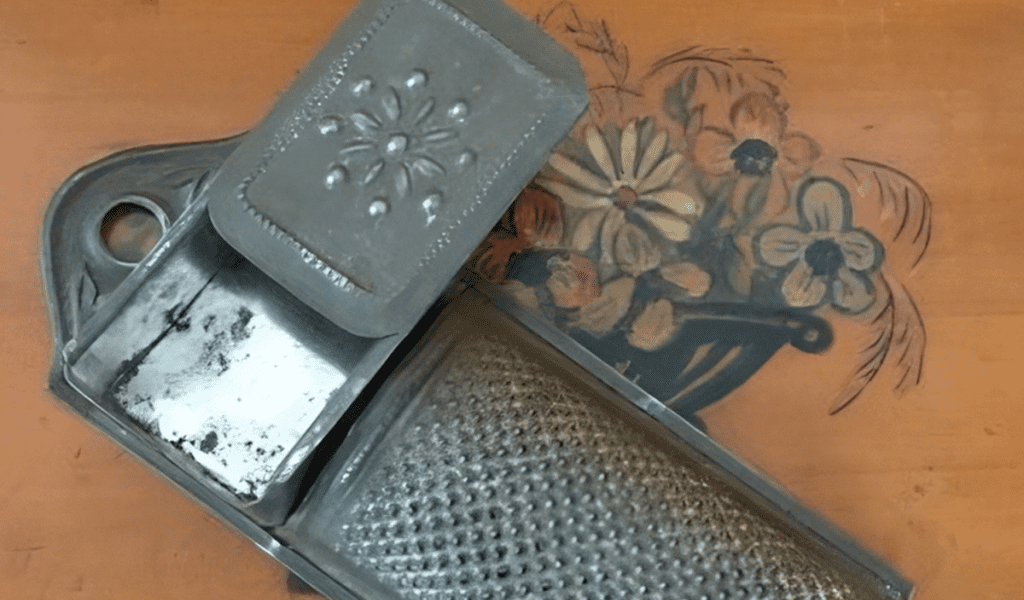The antique nutmeg grater is more than just a functional kitchen tool—it’s a symbol of culinary history, craftsmanship, and the global spice trade. This humble yet intricate device has stood the test of time, evolving from a luxurious item to a practical tool in kitchens worldwide. Let’s dive into the fascinating background of the antique nutmeg grater, from its historical roots to its modern-day legacy.
The Origins of Nutmeg: From the Banda Islands to European Kitchens

Nutmeg, a spice with a storied past, originates from the Banda Islands in Indonesia. By the 15th century, nutmeg had become one of the most sought-after commodities in the global spice trade. Its unique flavor and medicinal properties made it a prized possession, especially in European households. In fact, nutmeg was so valuable that it became a symbol of wealth and status. This high demand led to the creation of specialized tools like the nutmeg grater, designed to make extracting the spice easier and more efficient.
During this period, owning nutmeg and a grater was a mark of affluence. Nutmeg was not only used in food but also in remedies for a range of ailments, which further increased its importance. As a result, the antique nutmeg grater became an essential tool, reflecting both utility and luxury.
Intricate Craftsmanship: A Reflection of the Era
The early nutmeg graters were true works of art. These graters were crafted from various materials such as wood, metal, and even ivory, with intricate designs that showcased the skill of artisans of the time. Some were simple in design, while others were highly decorative, often engraved with patterns or adorned with unique shapes.
By the 18th and 19th centuries, as nutmeg became more accessible to the general public, nutmeg graters transitioned from high-end luxury items to practical tools used in everyday kitchens. However, even the most functional graters still maintained a sense of elegance and craftsmanship. Their designs often featured small compartments to store the nutmeg, making them both convenient and aesthetically pleasing.
How the Nutmeg Grater Was Used
The antique nutmeg grater was designed for both efficiency and ease of use. Most graters featured a simple design with a handle and a grating surface covered in small holes. To use it, the cook would place a whole nutmeg seed against the grating surface and apply pressure, creating finely grated shavings. These fresh shavings could then be added directly to food or drinks.
One of the key reasons why nutmeg graters became so popular was the distinct flavor of freshly grated nutmeg, which elevated many dishes. Grated nutmeg was used in a variety of recipes, from savory sauces and baked goods to beverages like eggnog and mulled wine. In many homes, especially during the holidays, the scent of freshly grated nutmeg became a beloved part of the cooking process.
Nutmeg also had a reputation for its medicinal benefits. It was believed to aid digestion, soothe stomach aches, and relieve symptoms of colds. As such, the nutmeg grater was not just a cooking tool but also a valuable part of herbal medicine in many cultures.
Nutmeg Graters and the Global Spice Trade

The history of the nutmeg grater is closely tied to the global spice trade, which shaped the culinary traditions of many countries. As European explorers discovered new trade routes to Asia, spices like nutmeg became more widely available. The increased demand for nutmeg led to the growth of spice markets, and with it, the popularity of tools like the nutmeg grater.
The global exchange of spices introduced nutmeg to new cuisines, enriching dishes across Europe and America. As nutmeg became a common ingredient in households, nutmeg graters became a staple kitchen tool, essential for extracting the spice’s flavor.
The Legacy of the Antique Nutmeg Grater

Today, antique nutmeg graters are not only valued for their functionality but also for their historical significance. These graters are cherished by collectors and cooking enthusiasts alike, appreciated for their craftsmanship and their connection to a rich culinary past. Many antique graters are now displayed as decorative items in kitchens and homes, reminding us of the time when spices like nutmeg were treasures of great value.
The legacy of the antique nutmeg grater is intertwined with the broader history of the spice trade, culinary traditions, and the evolution of kitchen tools. As we continue to explore the art of cooking, this humble grater serves as a reminder of how far we’ve come—from a time when spices were rare luxuries to today, where they are easily accessible in every supermarket.
Conclusion: A Culinary Artifact with a Rich History
The antique nutmeg grater is a fascinating relic of culinary history, embodying the global journey of nutmeg from the Banda Islands to kitchens around the world. It’s a tool that reflects the importance of spices in shaping cuisines and the craftsmanship that went into creating everyday items. Whether it’s displayed as a collector’s piece or still used in the kitchen, the nutmeg grater connects us to a rich heritage of flavor and tradition.
In essence, this small, unassuming tool carries with it a history of trade, craftsmanship, and cultural exchange that continues to inspire cooks and collectors alike. So, the next time you add a pinch of nutmeg to your dish, remember the humble grater that helped make this prized spice a kitchen staple for centuries.




